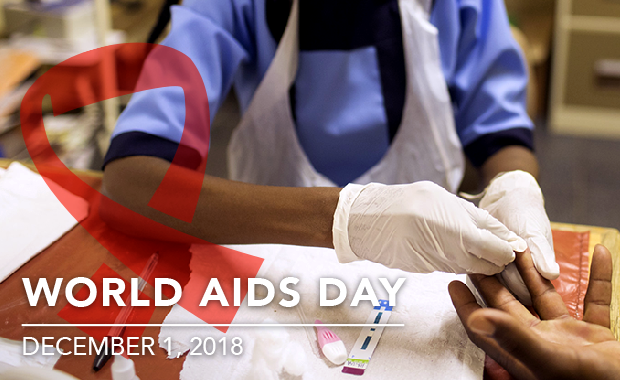Where We Work
See our interactive map



It won’t happen from an office or a conference room. It’ll happen on the front lines.
If ever there was a day we wish didn’t need commemorating, it’s World AIDS Day.
We wish the virus had never made the jump from chimps to humans, morphing from simian immunodeficiency virus to HIV and altering the course of history in the process. We wish it hadn’t orphaned countless children or infected them before they were even born. We wish it had never killed 39 million people and that there was no reason at all to mark December 1 this way, as we have for the past 30 years.
Fortunately, we’ve come a long way since 1988. And we’ve learned a few things about what it will take to end the AIDS epidemic once and for all.
Health workers are the front line of defense.
We know it won’t happen from an office or a gleaming conference room. It will have to happen locally—in the big cities and small towns and hard-to-reach villages around the world that are the front lines of the disease.
Here are three ways we in the global health community can work locally to help countries build the skills, systems, and self-reliance that will finally put the epidemic to bed.
Health workers are the front line of defense against new infections and treatment for those who need it.
These are doctors, lab techs, pharmacists. They’re nurses like Olivia Nandy in Namibia, who have the power to put clients at ease and coax them back to the clinic so they can adhere to their antiretroviral regimens. They’re community health workers like Nanzula Jagaja in Tanzania, who go door-to-door to link their neighbors to the essential primary health services they need. They’re clinic staff, like Raymond Havwala in Zambia, who are getting more men involved in their own health care (and putting a stop to gender-based violence while they’re at it).
By investing in health workers and creating incentives that draw them to the areas with greatest demand, we can help more countries strengthen the pipeline of labor and services they’ll need to serve this generation and the next.
This means building relationships with advocates and community leaders like Mrs. Pontoshi in Uganda and health workers who know and understand their communities like community liaison Pascacio Colop in Guatemala. They can reach transgender individuals, sex workers, and other members of the key populations that not only suffer higher rates of infection but are also often cut off from the HIV services they need.
It also means working with local organizations and hospitals to reach those who need care and attention now—like so many teenagers in remote Namibia who, infected at birth, are now learning how to cope with their lifelong disease and grow up at the same time. The attitudes and habits these young people develop now will guide them through a lifetime of treatment.
Countries aren’t looking to the international community to save the day or set their priorities.
“I remember driving from town to town in the north of Namibia just ten years ago and seeing graveyards where the small crosses that marked each grave started at the side of the road and disappeared into the distance,” says IntraHealth’s Kate Stratten. “We’ve made incredible global progress toward eliminating AIDS as a public health threat since then. HIV-related deaths are down, and access to treatment is up. But while numbers, targets, and results are important, they cannot take priority over providing comprehensive services for those who need them most.”
This is where the real solution lies.
By strengthening local and in-country capacity at all levels—from ministries of health and finance to health training institutions to the front lines of health care and social service—we as a global community can help end the epidemic for good.
And this means we need to listen and learn. Yes, we should keep refining our interventions, build greater global momentum, and pursue more treatment and prevention breakthroughs—but countries aren’t looking to the international community to save the day or set their priorities. They’re looking for partners who can fill gaps, share their know-how, and work alongside them to reach those who are in need today while strengthening their institutions to better serve future generations. And as more countries work to mobilize their own domestic resources to fund HIV services in the future, helping to strengthen their financial systems and planning today will be crucial.
The final push to end the epidemic won’t happen overnight. And it’ll take more than wishes from us. There will be years of tough conversations between now and then, and a recommitment from us all—not only to achieving our global goals, but to providing millions of people with excellent, consistent care.
Get the latest updates from the blog and eNews




